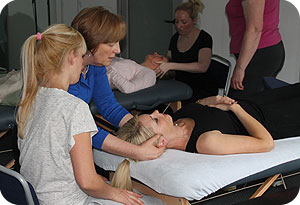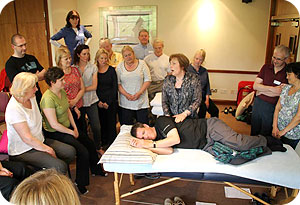I have a number of patients that come to me for TMJ, referred to me from several dental practices in my area. I find it  interesting work, and have found that the people referred fall into three groups:
interesting work, and have found that the people referred fall into three groups:
1.) THE PROBLEM:
People suffering from osteoarthritis or dislocation of the temporomandibular joint. This group is relatively small in my experience.
THE FIX:
These people often need to be helped by the dental surgeon. We are able to help with the soft tissue, to keep the joint relaxed and as form of pain relief. However ultimately, once diagnosed, it is best to refer back the dentist.
2.) THE PROBLEM:
Patients who have received dental treatment, and have as a result been sat in a dentist’s chair from anywhere between 1 to 3 hours, where they have been tense, fearful and holding tight the entire time. Staying so tense for such a period of time results in the body struggling to let go of the tension afterwards.
THE FIX:
In this case, lots of reassurance and explanation of what has happened is key. The muscular response is linked intrinsically to the emotional and neurological reaction of the event, and therefore we have to remind the muscles that they can relax. If we create soft tissue mobilisation that is pain free, the brain will establish that there is no longer a threat and cause the muscles to reset in a new relaxed state.
THE METHOD:
The best method I have found to achieve this is through Hendrickson Method soft tissue mobilisation. With the patient supine, I explain exactly what I am going to do, and then begin the treatment with anterior neck, paying special attention to scalenes, sternocleidomastoid and the hyoid group. I would then move on to the masseter, temporalis and digastric. I find once I have brought relaxation to the anterior, the posterior neck is ready to release.
3.) THE PROBLEM:
People with busy or stressful lives, who often present with a forward head position or rounded shoulders, creating compression through C1 and C2. These people are often found with clenching jaw, but with no awareness that is occurring. With these people, it is as much about communication as it is the hands on approach.
THE FIX:
With these people a subjective and thorough initial assessment is crucial, where we can establish the root of the cause through examining lifestyle.
THE METHOD:
It is vital to first assess posture, exploring tight versus weak muscles to determine the muscular pattern they have adapted to manage the stress of their lives. I find commencing the treatment with a side lying wave mobilisation® works best, which helps to relax the patient. Address tight muscles first with soft tissue mobilisation and METs, explaining clearly each step. I then give the patient ‘homework’ which consists of a breathing routine using the abdomen, side and back ribs and sternum, which helps relaxation and acts as an exercise in body awareness.
I encounter these three problems, and variations on them, frequently, and the methods I have outlined above are consistently successful in helping the patient. The real key to treating TMJ however is seeing each patient as completely individual, and establishing a clear line of communication to understand their pain.
To find out more:
Treatment of TMJ Dysfunction & Pain – 1 Day
 really struggling with chronic pain, this could be due to trauma, or impact injuries that occurred many years ago. Then there are the pain syndromes, chronic fatigue, fibro myalgia, ME. The thing they all have in common is that they leave the body with:
really struggling with chronic pain, this could be due to trauma, or impact injuries that occurred many years ago. Then there are the pain syndromes, chronic fatigue, fibro myalgia, ME. The thing they all have in common is that they leave the body with:

 .
. Each treatment is created just for them and often can and does change with their needs. It takes a great belief in yourself as a therapist to be flexible and also have a broad and deep understanding of your anatomy and physiology including sensitive communication skills that are clear, creative and empathic.
Each treatment is created just for them and often can and does change with their needs. It takes a great belief in yourself as a therapist to be flexible and also have a broad and deep understanding of your anatomy and physiology including sensitive communication skills that are clear, creative and empathic.